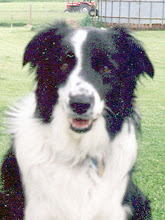Tuesday, June 30, 2009
Farm Rules
I work to keep the chickens in, and the starlings out.
I provide bedding and shelter for sheep and horses, and shoo away the coons and possums.
The cat may eat rats and mice and sparrows, but must leave the barn swallows and blue birds alone.
The dogs may chase squirrels and stray cats, but not the barn cats or chickens.
I may come to accept that some things I cannot control.
Monday, June 29, 2009
Llama Shearing: The Deed
Sedated llamas don’t look peaceful. They look dead.
When I don’t see the rise and fall of Llambert’s abdomen, I put my ear to his nose and hear his nasally breath.
Reassured that he’s alive – no need to shear a dead llama – I grab the shears.
With gloved hands, I grab a clump of hair. It’s about eight inches long and holds bits of manure, dirt and straw. Placing the shears at the base of the hair, near Llambert’s skin, I clip. The clump separates from his body.
I toss it aside, grab and clip another clump. Soon, I’m into a rhythm. Grab and clip. Grab and clip. Around me lie clumps of brown.
I view my work. He looks like a kindergartener with school scissors trimmed him.
The cut is uneven. Should I try to straighten it?
I look at my watch. Forty minutes are passed. The vet says the sedative lasts about an hour. I’ve only clipped one side.
The sheep won’t care what he looks like, I reason.
When Llambert awakes, I’ve removed most of the long hairs. Several feathery wisps remain on his hindquarters. I try to clip those and he kicks.
They give him an edgy look, I conclude as I remove his halter and let him to return to his sheep.
Sunday, June 28, 2009
Llama Shearing: The Solution
When the vet arrives for his spring visit, I hand him a to-do list.
Vaccinate horses.
Blood test for my show mare.
Float teeth.
Check lameness in my old mare.
Answer questions about sheep vaccinations and deworming.
Vaccinate and deworm llama.
Trim llama’s nails.
He grimaces when he gets to the bottom of the list.
“We’ll sedate him for that,” he says.
The vet injects a sedative into Llambert’s hindquarter, and then we sit on a bale of hay, watching and waiting.
Llambert’s eyelids get heavy. His head droops. He drops to the ground and lies in the straw.
The vet grabs his trimmers, steps into the stall and trims Llambert’s nails.
“If you’re planning on shearing him, you might want to do it now,” the vet says.
Saturday, June 27, 2009
Llama Shearing: The Tools
When I look at Llambert the Llama, I see sections. I’ve calculated how much hair I can clip with scissors before my hand protests. Night one, I can clip the shoulder. Night two, the other one. Night three, the neck.
It will be fall before I’m finished. Surely there has to be a better way.
I consult my farm supply catalog.
Heavy-duty clippers with 170 watts of power are $359. English-type shears powered by the human hand are $14.95.
I order the hand shears and shudder when they arrive. The six-inch blades close when I squeeze the handles and spring open when I release. They make hedge clippers look like children’s safety scissors.
Friday, June 26, 2009
Llama Shearing
I finished writing my novel and sheared a llama on the same day. The llama shearing seemed the greater accomplishment.
Llambert the Llama is not a friendly creature. He resists being caught; he kicks when handled; and he’s the hairiest beast on the farm. Unlike every other creature we own, he does not shed come springtime.
The arrival of spring brought the question, how does one shear a llama? Most pros use industrial clippers to remove the pounds of fiber. I, though, didn’t want to invest a few hundred dollars in clippers.
Would scissors work? Where would I start? How could I get him to stand still? Did I risk getting spit upon? I spent many evenings in the barn, staring at Llambert, contemplating his future haircut.
Thursday, June 25, 2009
Silent Night
At the butchers, a young man asks if I want to stay while they kill the roosters.
I say I have to run errands. I always say that. I can’t imagine sitting in the parking lot, waiting for the birds to be killed, plucked, put on ice.
When I return a few hours later, my roosters’ carcasses are on ice. The snow is still falling. Butchering is continuing. I hear the squawk of birds and smell the blood. Will I ever get used to the smell? I feel light-headed.
The young man motions that it will be a few minutes. I retreat to the storefront and wait.
Inside I hear the sound of a solo flute. Stepping around the corner, I see a woman standing and staring at sheet music lying on the floor. In her hands, she holds a flute. Outside the snow falls. Squawks come from the butchering floor. And she practices “Silent Night.”
Wednesday, June 24, 2009
The Rooster Mobile
The throaty song made me reach for the volume button. But the noise wasn’t coming from the car radio.
The car’s engine and movement apparently awoke one of the five roosters in the back seat. I stared at his reflection in the rearview mirror. How had my life come to this?
It was 7 in the morning on December 21 and I was driving to the butchers in heavy snow. Five Buckeye roosters were stirring in the back seat of my Honda Civic.
I didn’t feel like a farmer, but I also didn't feel like the political science major who'd graduated summa cum laude so many years ago.
Subscribe to:
Comments (Atom)












